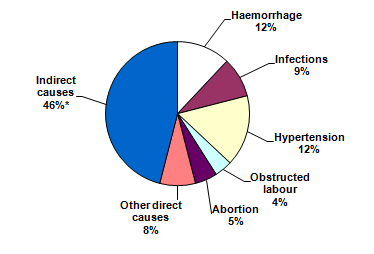
Causes of maternal death worldwide
Euna Lee and Laura Ling are in prison. Mallika Chopra is haunted by them: “I wanted to share a story about Euna Lee, who along with Laura Ling, has been held in N. Korea for 4 months. As a mother, the story has been haunting me since I heard it. It haunts me because I can totally relate to Euna’s actions.” Mothers in prison haunt the mothers of the world.
Chopra had dinner with Euna Lee’s husband Michael who recounted the story of how Euna struggled to send him an urgent note: “Euna wanted to make sure that Michael had sent in the registration form for Hana for summer school. Euna had chosen the Korean immersion school for her daughter, but was scared her husband would forget to send in the form! Hearing this story brought tears to my eyes. Sitting in captivity halfway around the world, a mom is still a mom.” Their daughter Hana is four years old.
Sitting in captivity halfway around the world, a mom is still a mom.
Lisa Belkin read Chopra’s account and was haunted as well: “When a friend of mine was weak with the cancer that would soon kill her, she began leaving Post-It notes around her bedroom for her husband. Thoughts on what to get their two sons for their birthdays. Reminders of playdates that were scheduled for the next few weeks. Suggested grocery lists. A mother is a mother as long as she lives.”
A mother is a mother as long as she lives.
“As long as she lives”. What does that mean in a world in which maternal mortality persists? “Every year some 536 000 women die of complications during pregnancy or childbirth, 99% of them in developing countries. The global maternal mortality ratio of 400 maternal deaths per 100 000 live births in 2005 has barely changed since 1990.”
Improving maternal health is one of the Millenium Development Goals, or MDGs, and it “constitutes the most off-track of all MDGs.” The thing about maternal mortality, about deaths in pregnancy or in childbirth complications is that almost all of them are preventable. Family planning, education, access to maternal and reproductive health care services would do the trick. A bit of money, a bout of commitment, and a dose of recognition that women actually matter would suffice.
Preventable maternal mortality haunts the globe.
Take South Africa, for example, whose Department of Health recently released a report on how the country is failing to save pregnant women and mothers. The report is titled Saving Mothers 2005 – 2007.
According to the report, “38.4% of the deaths were clearly avoidable within the health care system….There were 1519 (38.4%) clearly avoidable deaths within the health system….This is approximately the same as reported in 2002-2004 where the clearly avoidable deaths 36.7%….Four out of five of clearly avoidable maternal deaths were due to complications of hypertension, obstetric haemorrhage, pregnancy related sepsis and non-pregnancy related infections. The ways to prevent these deaths are known. Specific protocols have been developed and these have been included in the recommendations given in the previous report. Despite this, the most important avoidable factor is still substandard care. . . .Delay in seeking help was the most common patient related avoidable factor. The exact meaning of this is hard to establish as assessors can only use the data available in the case notes. If lack of transport or other factors inhibiting the woman seeking help is not recorded in the notes, the assessor will not be able to document them. Independent research has indicated most of the delays are due to the inability to access transport especially at night leading to delay, rather than lack of knowledge or concern by the patient.”
Women’s delays in seeking help is more often than not a factor of inaccessible transport than of the woman’s knowledge or concern. That is, it’s a function of everyday life for poor women, and especially for poor rural women, living and dying in South Africa. Those women, they haunt the trains, the collective taxis, the buses, the side of the road. They haunt the clinics and hospitals to which they never arrived and when they did, they were poorly cared for.
The report’s Conclusion is short, bitter, and to the point. Here it is in its entirety: “The final comment of the 1999-2001 report was “Every woman who becomes pregnant and continues with her pregnancy does so in the expectation of delivering a healthy child and the joy and satisfaction of watching the child grow. Surely, it is the duty of society and the health care profession to do the utmost to fulfil this expectation? To this end, the deficiencies identified in this report must be urgently addressed. The committee are anxious to see clear signs of progress by the next triennial report”. Unfortunately this, with the notable exception of women dying from complications of hypertension in pregnancy, has not come to pass. We will have to redouble our efforts.”
This is not just about South Africa nor is it about the `developing world’. This is about the globe. Them that’s got shall get. Them that’s not shall lose. So the Bible said, and it still is news.
Women who die of pregnancy and childbirth complications haunt the world. We mourn their loss, their absence, and honor their lives. Women who die of preventable pregnancy and childbirth complications, on the other hand, haunt our every days and every nights. We must do as they have done. Howl. We must do more than write reports and articles that begin and conclude, “As we said before, and it still is news.”
(Image Credit: Public Health Association of South Africa)